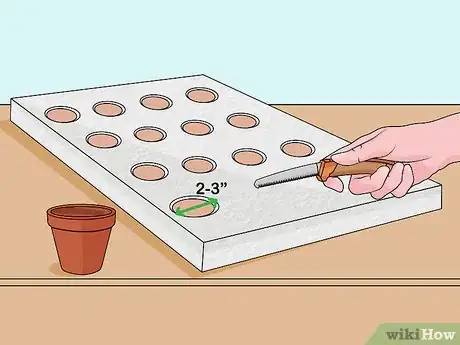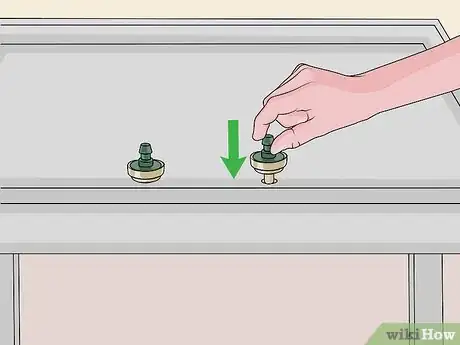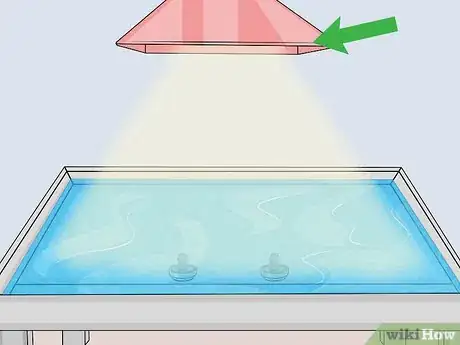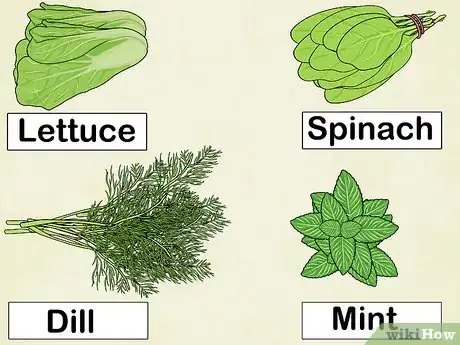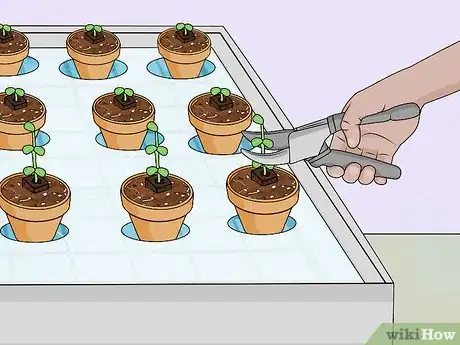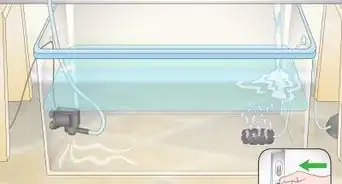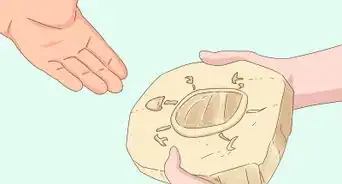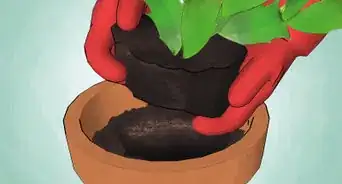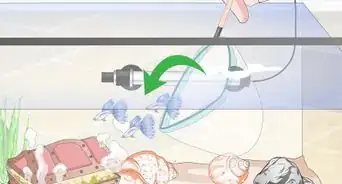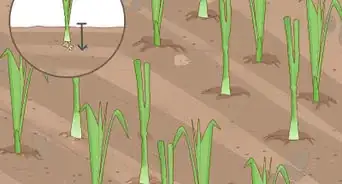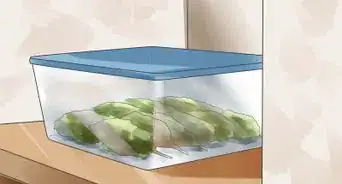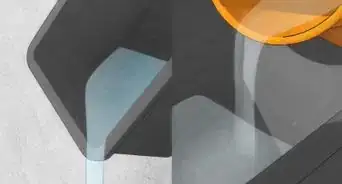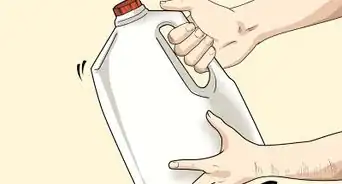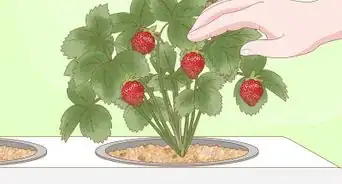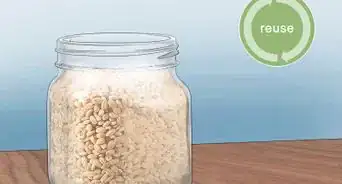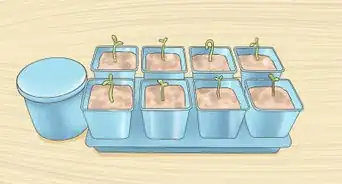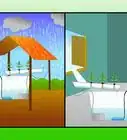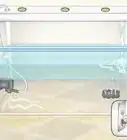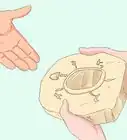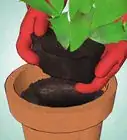This article was co-authored by Ryan Glynn, CPA. Ryan Glynn is a Plant Specialist, Interiorscaper, and the Founder of Chicago Plants, LLC. He specializes in houseplant care, interior plant-scaping, and gardening. Ryan and Chicago Plants have been featured in several media outlets such as TimeOut Magazine and the Chicago Tribune. Ryan holds a BBA and Master’s degree in Accounting from The University of Wisconsin-Madison.
wikiHow marks an article as reader-approved once it receives enough positive feedback. In this case, 100% of readers who voted found the article helpful, earning it our reader-approved status.
This article has been viewed 588,824 times.
Hydroponics is a gardening system where you grow plants in a soilless solution, usually water. A hydroponic garden has a 30-50 percent faster growth rate and a larger yield than a soil garden. Hydroponic gardens also have fewer issues with bugs, pests, and diseases. To build your own hydroponic garden, start by constructing the hydroponic system. Then, add the crops to the system so they can grow. Maintain the hydroponic garden as it develops and enjoy happy, healthy plants at home.
Steps
Constructing the Hydroponic System
-
1Build the flood table. The flood table will hold the water for the garden. You can build a simple flood table out of wood. The width of the flood table will depend on how much you want to grow in the garden and how much water you want to use.[1]
- For a small garden, make a rectangular frame out of treated lumber that is 4 feet, 1-inch (1.2 metres, 2.54 cm) wide by 8 feet, 1-inch long (2.4 metres, 2.54 cm). Then, line it with a polyethylene plastic sheet. This will hold 20 gallons (75 L) of water.
- You can also use a wide, deep plastic tray as the flood table. Pick a container that can hold 10 to 20 gallons (38 to 75 L) of water. You may want to line the tray with plastic to ensure it does not leak.
-
2Make a floating platform out of styrofoam. To prevent the roots and soil of the plants from rotting, make a floating platform so they can float in the water. For a small garden, use a 4 by 8 foot (1.2 by 2.4 metre) sheet of 1 ½ inch (3.8 cm) thick styrofoam. Check that the edges of the platform can move up and down so the plants can float.[2]Advertisement
-
3Cut 2 to 3 inch (5 to 7 cm) wide holes in the platform. Use a plant pot as a guide when cutting the holes with a saw. Cut enough holes to fit all the plants you want to grow. Make sure the plant pots fit snuggly in the holes and do not extend beyond 1/16 inch (0.4 cm) below the styrofoam platform.
-
4Add drip emitters to the flood table. Drip emitters help to drip out water from the garden to ensure the water does not sit stagnant in the flood table. You can find them in the irrigation supply section at your local hardware store or nursery. They come in different drip rates, based on maximum gallons per hour (gph).[3]
- For a standard garden, you want the flood table to hold 5 gallons (19 L) of water per hour. So, get two drip emitters that have a rate of 2gph.
- Puncture two holes in the bottom of the flood table. Then, push the drip emitters into the holes. Seal any gaps around the drip emitters with epoxy or hot glue.
-
5Place the flood table on a stand with a bucket. The flood table will need to be elevated on a stand or stool. Place a bucket under the flood table, directly underneath the drip emitters. The bucket will catch the water as it drips out of the flood table.[4]
- If you are growing the hydroponic garden outside, place it in a sunny spot in your yard. Position the flood table so it gets a maximum amount of sun.
-
6Fill the flood table with water. Pour enough water to fill the flood table halfway. Depending on the size you have chosen for your flood table, this may require 5 to 20 gallons (19 to 75 L) of water.[5]
- You can always add more water to the flood table once you add the crops.
-
7Set up grow lights if you are growing indoors. Hydroponic gardens can be grown outdoors in warm climates, especially climates that tend to get year-round sunlight. If you are growing the garden indoors, you will need grow lights. Use metal halide lights or sodium bulbs.[6]
- Position the grow lights over the flood table so it gets a lot of light.
-
8Get plant food. You will then need to add nutrient-rich plant food or fertilizer to the water so the plants can thrive. Look for plant food rich in calcium, magnesium, and other nutrients at your local plant supply store or gardening center.
- You can buy plant food specifically formulated for a hydroponic garden. It will be rich in the nutrients needed for plants grown in water.
Adding the Crops
-
1Go for leafy greens and herbs. Hydroponic gardens are best for plants with shallow roots, such as leafy greens like lettuce, spinach, and kale. You can also grow herbs like mint, basil, and dill.[7]
- Choose plants that have similar light and water needs. This way, when they grow close together in the garden, they all do well and thrive.
- As you expand your hydroponic garden, you may be able to grow vegetables with deep roots like beets, squash, and cucumbers.
- Start small by choosing just 1 or 2 plants to grow. All plants have different needs in terms of nutrients, and will require a specific fertilization schedule. It's easiest to start with 1-2 plants so you can figure out which nutrients you need and learn what issues to watch for (and how to correct them).
-
2Make the potting mixture. Start with a base that will provide moisture and air for the plants. Use eight parts perlite and one part coco fiber. You can also use vermiculite or peat moss instead of coco fiber.[8]
- If you live in an arid climate, add more coco fiber to the perlite. For a humid climate, add less coco fiber.
-
3Put the mixture in planting pots. Use 4-inch pots that have holes on the bottom, or netted planting pots. The holes will allow the plants to get water and plant food in the hydroponic garden. Fill the pots ⅓ of the way with the mixture.
-
4Plant the crops. Use sprouted seedlings in cubes of soil. Place the cube with the started seedling in the pot. Pour media around the sides and top of the plant. It should be snug in the pot.[9]
- Using seedlings that have already been planted and started will make it easier for you to get your garden off the ground. Put one cube of started seedlings per pot.
-
5Place the crops in the flood table. Water the crops lightly and then place them in the flood table. If you are using a floating platform, place the pots in the cut holes. If you are not using a floating platform, simply place them in the water in the flood table.[10]
- Make sure the roots of the plants are submerged in the water only ⅙ of an inch. This will ensure the roots do not get too wet but still get enough water to thrive.
Maintaining the Hydroponic Garden
-
1Water the plants once a day. Water the plants at the base every day. If they start to wilt, water them twice a day. You should also add more water to the flood table if it starts to look scarce.[11]
- If the plants do not thrive as much as you’d like, they may not be getting enough air and too much moisture. Check if the roots of the plants are rotting. If they are starting to rot or smell, move them higher up so their roots are less submerged in the water.
-
2Add more plant food as needed. The water in the flood table should drip slowly out through the drip emitters into the bucket underneath. This can take seven to 10 days. As this happens, add a fresh batch of plant food to the bucket and more water. Then, pour the contents of the bucket into the flood table.[12]
- This will ensure the plants get the nutrients they need as they grow in the hydroponic garden.
-
3Confirm the plants are getting enough light. If you are growing the hydroponic garden outdoors, make sure the plants get constant, direct sunlight 10-15 hours a day. If you are growing the garden indoors, have grow lights on the plants for 15-20 hours. Set up the lights on a timer so they shut off automatically at a set time each day.[13]
- You can buy grow lights that come with a timer. Or you can set a timer yourself and shut off the grow lights as needed.
-
4Harvest the garden as it grows. Use clean gardening shears to trim the garden. Prune the garden for size and for eating. Cut leaves for eating at the stem. Harvest your yield as it grows so it thrives.
- You can then add new plants to the flood table or replace existing plants based on your needs.
Community Q&A
-
QuestionHow do I start seeds for use in this system?
 Community AnswerMost growers recommend starting seeds in a hydroponic medium such as rockwool. When the seedlings are large enough, they can be transferred to the net pots.
Community AnswerMost growers recommend starting seeds in a hydroponic medium such as rockwool. When the seedlings are large enough, they can be transferred to the net pots. -
QuestionWould this garden be appropriate for an RV park?
 Community AnswerYes if you use the Kratky method which does not require electricity.
Community AnswerYes if you use the Kratky method which does not require electricity. -
QuestionHow do I get information on building and operating an aquaponic farm for raising shellfish?
 Community AnswerTalk to your local fishery. Not only can they provide information on the subject, they may also have extra materials to donate.
Community AnswerTalk to your local fishery. Not only can they provide information on the subject, they may also have extra materials to donate.
Things You'll Need
- Wood or a plastic container
- Styrofoam
- Water
- Drip emitters
- Bucket and stand
- Plant food
- Started seeds
- Potting mixture
- Grow lights (optional)
- Timer (optional)
References
- ↑ http://edis.ifas.ufl.edu/hs184
- ↑ http://edis.ifas.ufl.edu/hs184
- ↑ http://makezine.com/projects/hydroponic-veggie-garden/
- ↑ http://makezine.com/projects/hydroponic-veggie-garden/
- ↑ http://edis.ifas.ufl.edu/hs184
- ↑ https://www.mnn.com/your-home/organic-farming-gardening/stories/how-to-start-your-own-hydroponic-garden
- ↑ https://www.mnn.com/your-home/organic-farming-gardening/stories/how-to-start-your-own-hydroponic-garden
- ↑ http://makezine.com/projects/hydroponic-veggie-garden/
- ↑ http://makezine.com/projects/hydroponic-veggie-garden/
About This Article
To build a hydroponic garden, begin by constructing a flood table out of treated lumber or a large plastic tray. You'll then need to build a floating platform out of styrofoam that will be placed in the flood table on top of the water. In this platform, cut 2 to 3 inch holes where your plants will sit and add drip emitters that will run down beneath the flood table into a bucket. You will need to install grow lights and get potting mixture before you begin planting your seeds, which will sit in the floating platform. For tips from our Editor reviewer on getting your plants the right amount of water, keep reading.


